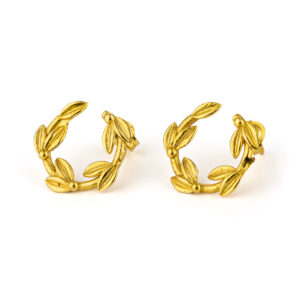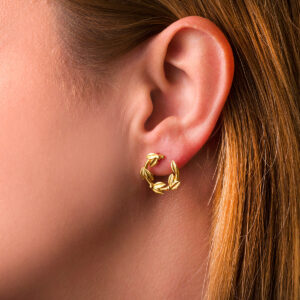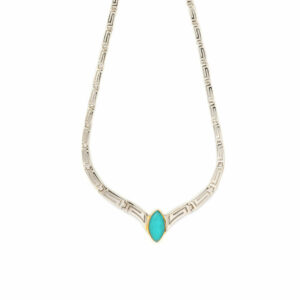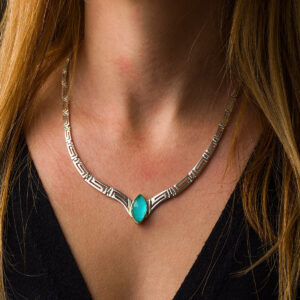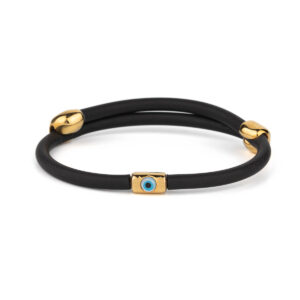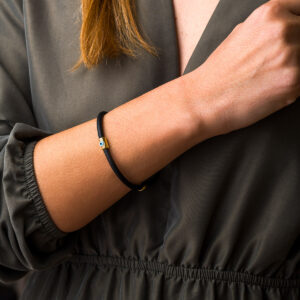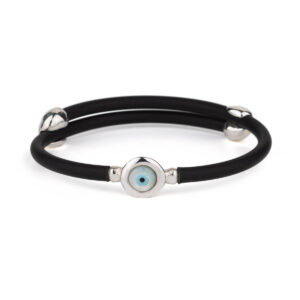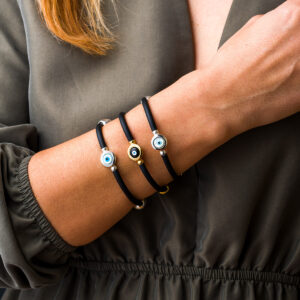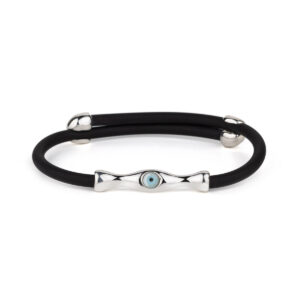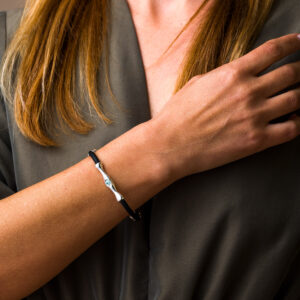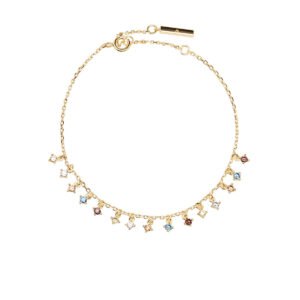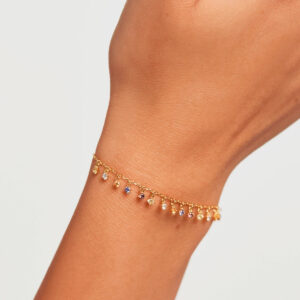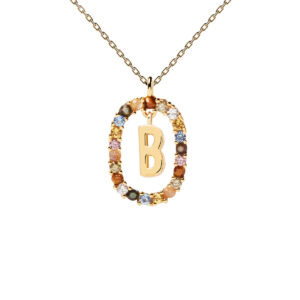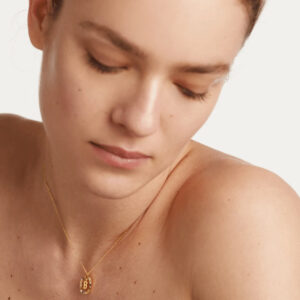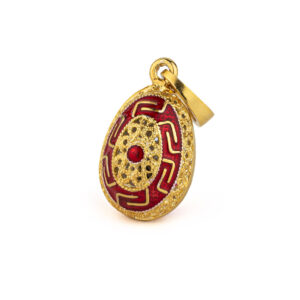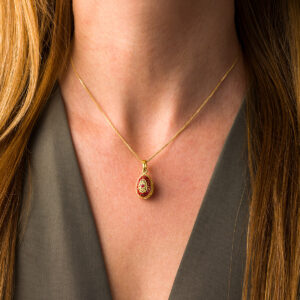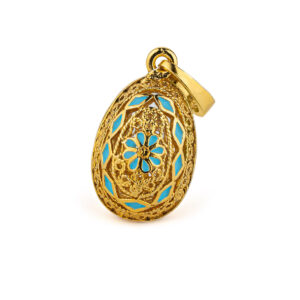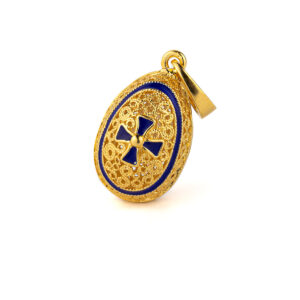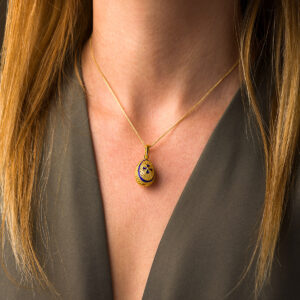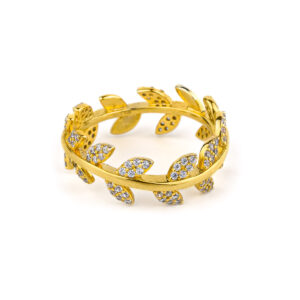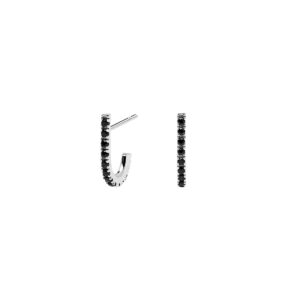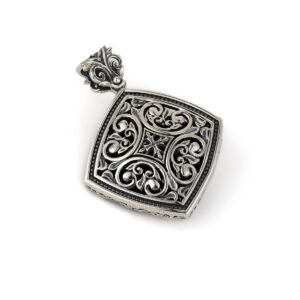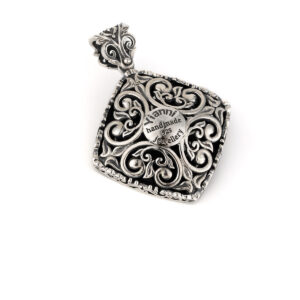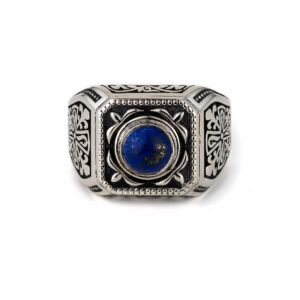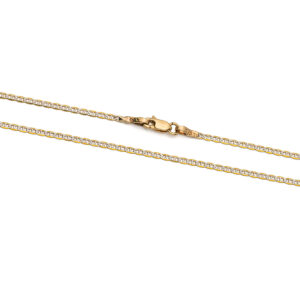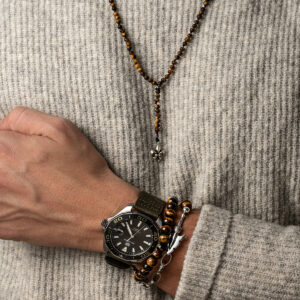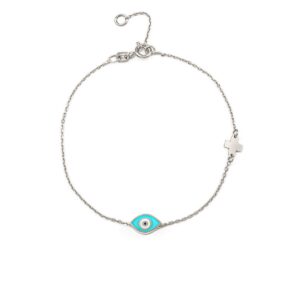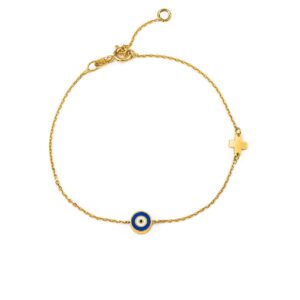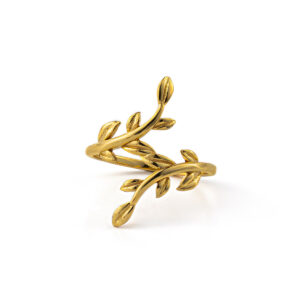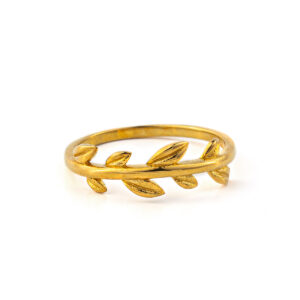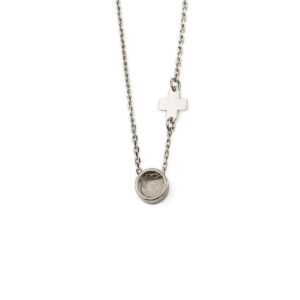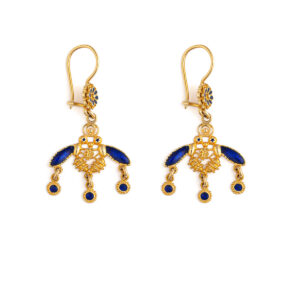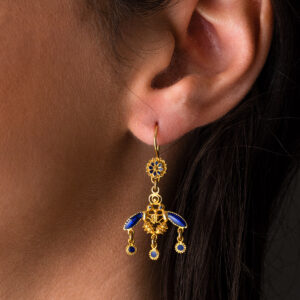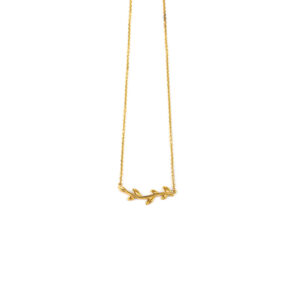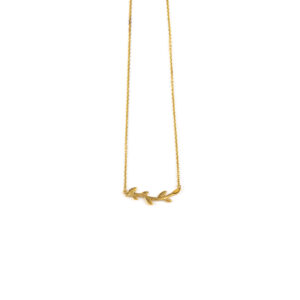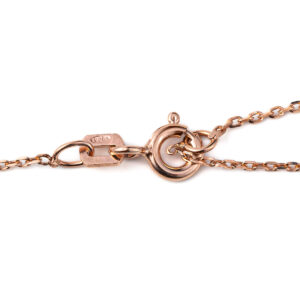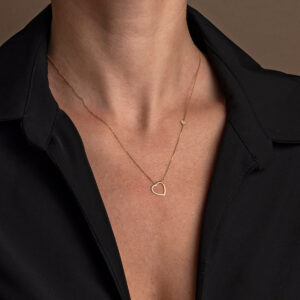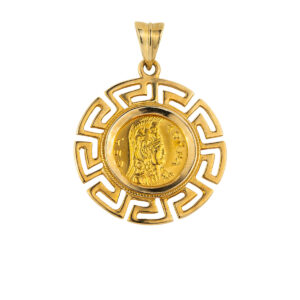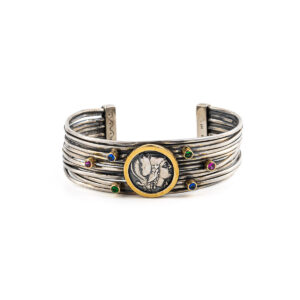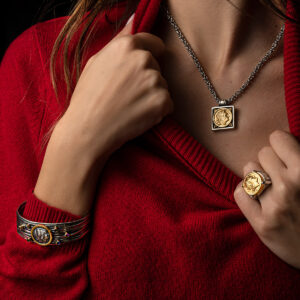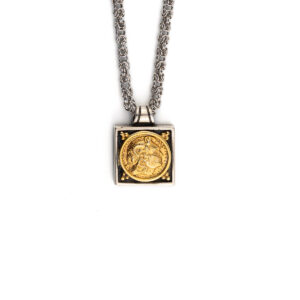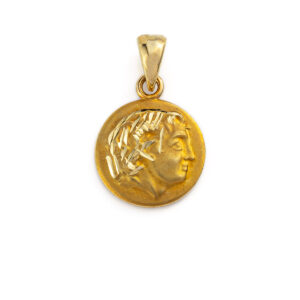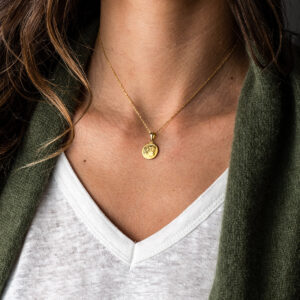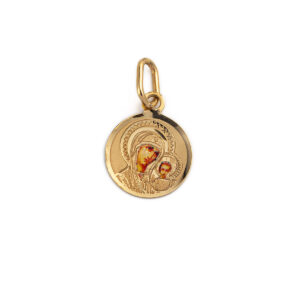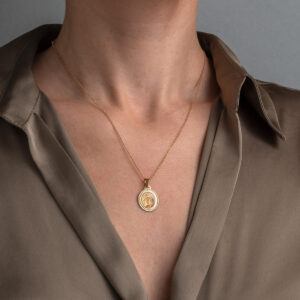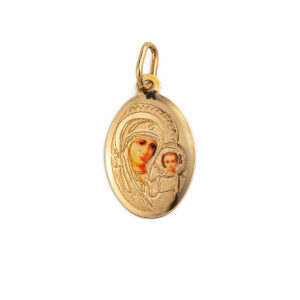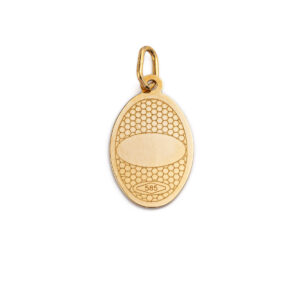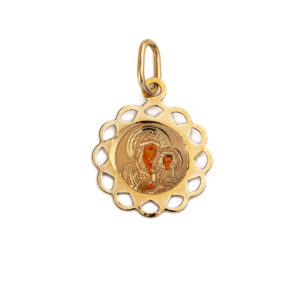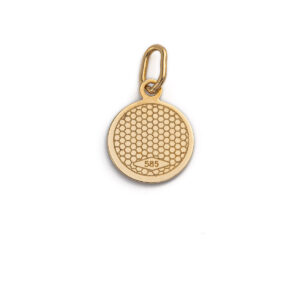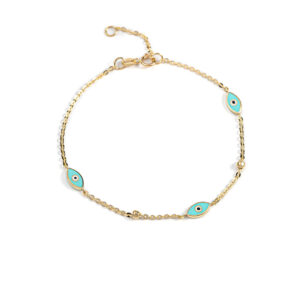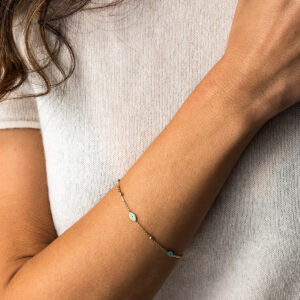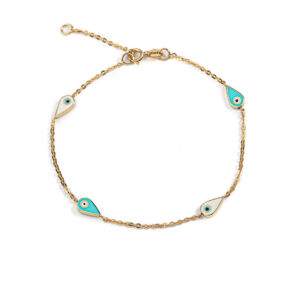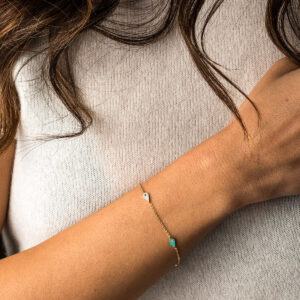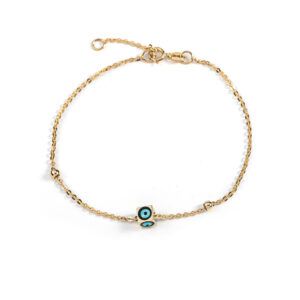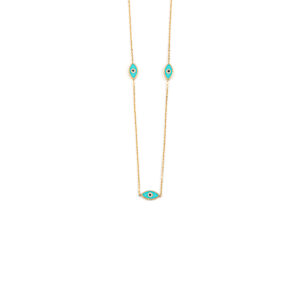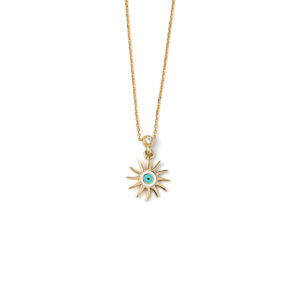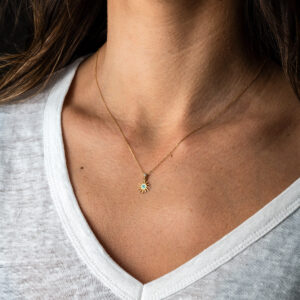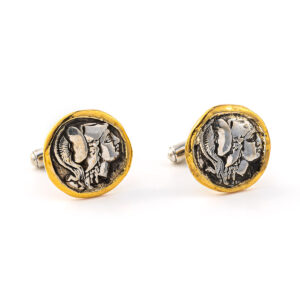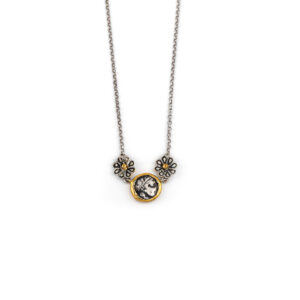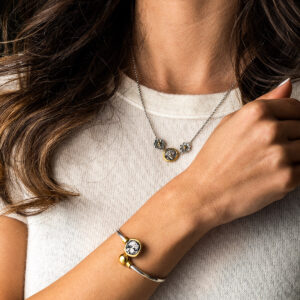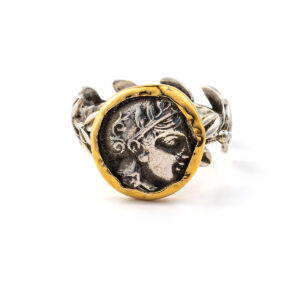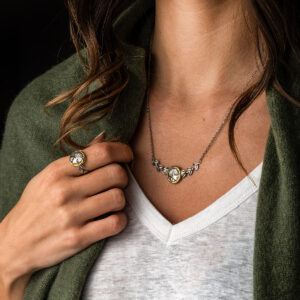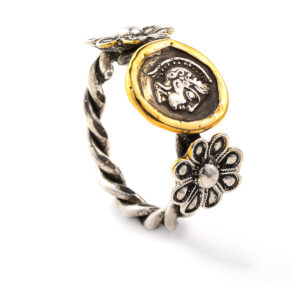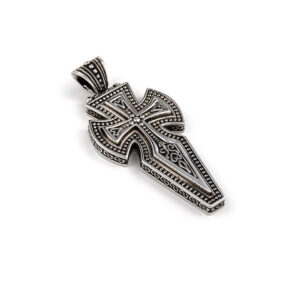Olive Branch Stud Earrings – Sterling Silver and Gold Plated
These earrings are inspired from the ancient olive wreath!
The olive wreath also known as kotinos was the prize for the winner at the ancient Olympic Games. It was an olive branch, of the wild- olive tree that grew at Olympia, intertwined to form a circle or a horse-shoe.
Made of sterling silver and gold plated.
Handmade item.
Greek Key Necklace with Amazonite – 14K Gold and 925 Sterling Silver
This stunning necklace features an amazonite stone.
Made of 925 sterling silver and 14k gold.
Handmade item. As in all handmade items there may be small differences in weight and dimensions and this is what makes them unique and precious.
Fildisi Evil Eye Caoutchouc Bracelet – Sterling Silver and Gold Plated
Made of 925⁰ sterling silver
Handmade item.
Evil Eye The symbol and superstition of the evil eye is one of the strongest symbolic images in the world. The earliest known evidence for belief in the evil eye goes back to ancient Greece and Rome. It is supposed to wear off evil to anyone who wears it and various cultures believe in that, however in Greece, it’s blue because at that time blue eyes were not so common and were thought to give the evil eye, so the blue is like a mirror to them. Nowadays it’s widely known and has become a trend.
Fildisi Round Evil Eye Caoutchouc Bracelet – 925 Sterling Silver
Made of 925⁰ sterling silver
Handmade item.
Evil Eye The symbol and superstition of the evil eye is one of the strongest symbolic images in the world. The earliest known evidence for belief in the evil eye goes back to ancient Greece and Rome. It is supposed to wear off evil to anyone who wears it and various cultures believe in that, however in Greece, it’s blue because at that time blue eyes were not so common and were thought to give the evil eye, so the blue is like a mirror to them. Nowadays it’s widely known and has become a trend.
Evil Eye Caoutchouc Bracelet – 925 Sterling Silver
Made of 925⁰ sterling silver
Handmade item.
Evil Eye The symbol and superstition of the evil eye is one of the strongest symbolic images in the world. The earliest known evidence for belief in the evil eye goes back to ancient Greece and Rome. It is supposed to wear off evil to anyone who wears it and various cultures believe in that, however in Greece, it’s blue because at that time blue eyes were not so common and were thought to give the evil eye, so the blue is like a mirror to them. Nowadays it’s widely known and has become a trend.
PD Paola Willow Gold Bracelet
65,00€This design is characterized by the five colorful protagonist stones that decorate it. 925 sterling silver with an 18k gold plating is combined with corundum sapphire blue, rhodolite, golden yellow, pure white, and champagne hues that twist the piece turning it into a delicate jewel, taking on the natural beauty of wildlife.
PD Paola Letter B Necklace – 18k Gold plating
The force of a name knows no boundaries. A name bears truth, it tells a story. Bringing self-love as a permanent state of mind, this collection frames uniqueness and celebrates confidence in a newness design scenario. Bringing back the nineties’ and giving a twist to their beautiful nostalgia, floating letters rise as the innovative and distinctive personal symbol: a new reality is born from a piece of jewelry that empowers your true self and says your name out loud.
Labradorite, Tiger Eye, Mother of Pearl and crystals blend in a bright squarish oval that saves your initial like a treasure, giving life to a necklace design that will become the timeless icon of your own. Like floating in the air, an 18k gold plated initial hangs inside the amulet, a prominent piece made of 925 silver as your ultimate bold statement. Surrounding color hues and veins in the natural gemstones are singular characteristics in each necklace, making every letter genuinely unique in the world.
*Gemstones may slightly vary in tone due to their natural origin.
Greek Key Filigree Egg Pendant Necklace with Red Enamel – Sterling Silver Gold Plated
The pendant is embellished with a fine filigree and red enamel in Faberge style. Also the pendant decorated with Meander – Greek Key design.
The chain shown is included.
Used as a charm or as a pendant.
Pick up a beautiful Easter gift!
Made of 925 sterling silver and gold plated.
Rosette Filigree Egg Pendant Necklace – Sterling Silver Gold Plated Enamel
A beautifully crafted egg-shaped pendant with a rosette, made of 925 sterling silver and gold plated decorated with very detailed filigree motifs.
The chain shown is included.
Used as a charm or as a pendant.
Pick up a beautiful Easter gift!
Made of 925 sterling silver and gold plated.
Egg Pendant Necklace with Cross – Sterling Silver Gold Plated and Enamel
A beautifully crafted egg-shaped pendant with a cross, made of 925 sterling silver and gold plated decorated with enamel and very detailed filigree motifs.
Made of 925 sterling silver and gold plated.
The chain shown is included.
Filigree is a delicate kind of jewelry metalwork, made with tiny beads or twisted threads, or both in combination, soldered together or to the surface of an object of the same metal and arranged in artistic motifs. The art of filigree dates back to ancient history. The first of the found jewelry in this technique has been found in Mesopotamia and dates to thousands of years BC. In the ancient world and particularly in Asia Minor, this art grew at the highest level.
Fabergé egg is a jeweled egg created by the House of Fabergé, in St. Petersburg, Imperial Russia. Virtually all were manufactured under the supervision of Peter Carl Fabergé between 1885 and 1917,[citation needed] the most famous being the 50 “Imperial” eggs, 43 of which survive, made for the Russian Tsars Alexander III and Nicholas II as Easter gifts for their wives and mothers. The first Fabergé egg was crafted for Tsar Alexander III, who had decided to give his wife, Empress Maria Feodorovna, an Easter egg in 1885. Peter Carl Fabergé was a Russian jeweler best known for the famous Fabergé eggs made in the style of genuine Easter eggs, using precious metals and gemstones. He’s the founder of the famous jewelry legacy House of Fabergé. (Wikipedia)
Meander or Meandros design, one of the most historic symbols of the Greek World, also called Greek Key and symbolizes long life and eternity. The pattern with Meandro was used in antiquity to decorate the frieze of temples.
Meander Filigree Egg Pendant Necklace with Turquoise Enamel – Sterling Silver Gold Plated
The pendant is embellished with fine filigree and turquoise enamel in Faberge style. Also, the pendant is decorated with a Meander design.
Made of 925 sterling silver and gold plated.
The chain shown is included.
Filigree is a delicate kind of jewelry metalwork, made with tiny beads or twisted threads, or both in combination, soldered together or to the surface of an object of the same metal and arranged in artistic motifs. The art of filigree dates back to ancient history. The first of the found jewelry in this technique has been found in Mesopotamia and dates to thousands of years BC. In the ancient world and particularly in Asia Minor, this art grew at the highest level.
Fabergé egg is a jeweled egg created by the House of Fabergé, in St. Petersburg, Imperial Russia. Virtually all were manufactured under the supervision of Peter Carl Fabergé between 1885 and 1917,[citation needed] the most famous being the 50 “Imperial” eggs, 43 of which survive, made for the Russian Tsars Alexander III and Nicholas II as Easter gifts for their wives and mothers. The first Fabergé egg was crafted for Tsar Alexander III, who had decided to give his wife, Empress Maria Feodorovna, an Easter egg in 1885. Peter Carl Fabergé was a Russian jeweler best known for the famous Fabergé eggs made in the style of genuine Easter eggs, using precious metals and gemstones. He’s the founder of the famous jewelry legacy House of Fabergé. (Wikipedia)
Meander or Meandros design, one of the most historic symbols of the Greek World, also called Greek Key and symbolizes long life and eternity. The pattern with Meandro was used in antiquity to decorate the frieze of temples.
Egg Pendant Necklace with Enamel – Sterling Silver Gold Plated
A beautifully crafted egg – shaped pendant, made of 925 sterling silver and gold plated with turquoise enamel.
Used as a charm or as a pendant.
Pick up a beautiful Easter gift!
The chain shown is included.
Olive Leaf Zircon Ring – 925 Sterling Silver and Gold Plated
Ring inspired by the olive leaf symbol.
Made of 925 Sterling Silver and Gold Plated
The olive wreath also known as kotinos was the prize for the winner at the ancient Olympic Games. It was an olive branch, of the wild- olive tree that grew at Olympia, intertwined to form a circle or a horse-shoe. According to Pausanias it was introduced by Heracles as a prize for the running race winner to honour his father Zeus. In the ancient Olympic Games there were no gold, silver, or bronze medals. There was only one winner per event, crowned with an olive wreath made of wild-olive leaves from a sacred tree near the temple of Zeus at Olympia. Olive wreaths were given out during the 2004 Summer Olympics in Athens in honor of the ancient tradition, because the games were being held in Greece.
PD PAOLA BLACK BIRD EARRINGS – 925 STERLING SILVER
49,00€Unique Pd Paola earrings from the L’Essentiel collection, made of sterling silver, decorated with Zirconia. Making reference to the most important values of life, these designs are an intentional statement about essentiality: truth and beauty are found in the roots. 925 sterling silver dainty jewelry with black and white zirconia build a minimalist setting where the effortless elegance shines by itself.
Cross Filigree Pendant Sterling Silver – Yianni Jewelry
Made of 925° sterling silver.
Handmade Item.
Silver creations of Yianni Jewelry, created by Garbis Khacherian, a silversmith trader since 1987.
Lapis Cross Signet Ring – Sterling Silver Yianni Jewelry
Made of 925⁰ sterling silver
Silver creations of Yianni Jewelry, created by Garbis Khacherian, a silversmith trader since 1987.
Explore Yianni Jewellery
Fleurs De Lis Rosary Necklace with Tiger Eye Beads – 925 Sterling Silver
Sterling Silver Fleurs de lis on Hand Crafted rosary with tiger eye beads.
Made of 925 sterling silver.
The Fleur-de-lis, is a stylized lily (in French, Fleur and lis mean ‘flower’ and ‘lily’ respectively) that is used as a decorative design or symbol. The Fleur-de-lis is particularly associated with France, notably during its monarchical period. As France is a historically Catholic nation, the Fleur-de-lis became at one, religious, political, dynastic, artistic, and emblematic symbol.
Evil Eye Turquoise Enamel Bracelet with Cross – 925 Sterling Silver
Evil eye bracelet with enamel.
Made of 925 sterling silver.
Evil Eye
The symbol and superstition of the evil eye is one of the strongest symbolic images in the world. The earliest known evidence for belief in the evil eye goes back to ancient Greece and Rome. It is suppose to wear off evil to anyone who wears it and various cultures believe in that, however in Greece it’s blue because at that time blue eyes were not so common and were thought to give the evil eye, so the blue is like a mirror to them. Nowadays it’s widely known and has became a trend.
Round Enamel Evil Eye Bracelet with Cross – Sterling Silver and Plated
Evil eye bracelet with blue enamel.
Made of 925 sterling silver and gold plated.
Evil Eye
The symbol and superstition of the evil eye is one of the strongest symbolic images in the world. The earliest known evidence for belief in the evil eye goes back to ancient Greece and Rome. It is supposed to wear off evil to anyone who wears it and various cultures believe in that, however in Greece it’s blue because at that time blue eyes were not so common and were thought to give the evil eye, so the blue is like a mirror to them. Nowadays it’s widely known and has become a trend.
Olive Branch Ring – 18K Solid Yellow Gold
680,00€Ring inspired by the olive leaf symbol.
Made of 18k gold.
The olive wreath also known as kotinos was the prize for the winner at the ancient Olympic Games. It was an olive branch, of the wild- olive tree that grew at Olympia, intertwined to form a circle or a horse-shoe. According to Pausanias it was introduced by Heracles as a prize for the running race winner to honour his father Zeus. In the ancient Olympic Games there were no gold, silver, or bronze medals. There was only one winner per event, crowned with an olive wreath made of wild-olive leaves from a sacred tree near the temple of Zeus at Olympia. Olive wreaths were given out during the 2004 Summer Olympics in Athens in honor of the ancient tradition because the games were being held in Greece.
Olive Branch Ring – 14K Solid Yellow Gold
514,00€Ring inspired by the olive leaf symbol.
Made of 14k gold.
The olive wreath also known as kotinos was the prize for the winner at the ancient Olympic Games. It was an olive branch, of the wild- olive tree that grew at Olympia, intertwined to form a circle or a horse-shoe. According to Pausanias it was introduced by Heracles as a prize for the running race winner to honour his father Zeus. In the ancient Olympic Games there were no gold, silver, or bronze medals. There was only one winner per event, crowned with an olive wreath made of wild-olive leaves from a sacred tree near the temple of Zeus at Olympia. Olive wreaths were given out during the 2004 Summer Olympics in Athens in honor of the ancient tradition because the games were being held in Greece.
Leaf Ring – 18K Solid Yellow Gold
554,00€Ring inspired by the olive leaf symbol.
Made of 18k gold.
The olive wreath also known as kotinos was the prize for the winner at the ancient Olympic Games. It was an olive branch, of the wild- olive tree that grew at Olympia, intertwined to form a circle or a horse-shoe. According to Pausanias it was introduced by Heracles as a prize for the running race winner to honour his father Zeus. In the ancient Olympic Games there were no gold, silver, or bronze medals. There was only one winner per event, crowned with an olive wreath made of wild-olive leaves from a sacred tree near the temple of Zeus at Olympia. Olive wreaths were given out during the 2004 Summer Olympics in Athens in honor of the ancient tradition because the games were being held in Greece.
Leaf Ring – 14K Solid Yellow Gold
395,00€Ring inspired by the olive leaf symbol.
Made of 14k gold.
The olive wreath also known as kotinos was the prize for the winner at the ancient Olympic Games. It was an olive branch, of the wild- olive tree that grew at Olympia, intertwined to form a circle or a horse-shoe. According to Pausanias it was introduced by Heracles as a prize for the running race winner to honour his father Zeus. In the ancient Olympic Games there were no gold, silver, or bronze medals. There was only one winner per event, crowned with an olive wreath made of wild-olive leaves from a sacred tree near the temple of Zeus at Olympia. Olive wreaths were given out during the 2004 Summer Olympics in Athens in honor of the ancient tradition because the games were being held in Greece.
Leaf Zircon Necklace – 14k Yellow Gold
492,00€Made in 14K gold with zircon.
A necklace inspired by the olive branch, a symbol of peace, abundance and achievement.
Handmade item.
White Round Eye Necklace with Cross – Sterling Silver
Evil eye necklace with white enamel.
Made of 925 sterling silver.
Evil Eye
The symbol and superstition of the evil eye is one of the strongest symbolic images in the world. The earliest known evidence for belief in the evil eye goes back to ancient Greece and Rome. It is supposed to wear off evil to anyone who wears it and various cultures believe in that, however in Greece it’s blue because at that time blue eyes were not so common and were thought to give the evil eye, so the blue is like a mirror to them.
Minoan Malia Bees Dangle Earrings – 18K Solid Yellow Gold and enamel
1.134,00€Dangle earrings inspired by the ancient Minoan Greek Malia bees pendant.
Made of 18K Gold.
Handmade item.
The Minoan Bees Pendant, one of the most famous Minoan artworks, was discovered in the Old Palace cemetery at Chrysolakkos, outside the palace of Malia, the third largest and most significant known Minoan palace after Knossos and Phaistos. Chryssolakkos means the “Pit of gold” because of the many precious objects that were found there. The famous pendant dates back to the Bronze Age, (1800 BC) and it’s a stunning, very detailed representation of two bees or wasps storing away a drop of honey in their honeycomb. This pendant is one of the most famous exhibits in the wonderfully Heraklion archeological museum.
As in all handmade items, there may be small differences in weight and dimensions and this is what makes them unique and precious.
Leaf Necklace – 14k Yellow Gold
408,00€Made in 14K gold.
A necklace inspired from the olive branch, a symbol of peace, abundance and achievement.
Handmade item.
Turquoise Enamel Eye Necklace with Cross – Sterling Silver and Rose Gold Plated
Evil eye necklace with turquoise enamel.
Made of sterling silver and rose gold plated
Evil Eye
The symbol and superstition of the evil eye is one of the strongest symbolic images in the world. The earliest known evidence for belief in the evil eye goes back to ancient Greece and Rome. It is suppose to wear off evil to anyone who wears it and various cultures believe in that, however in Greece it’s blue because at that time blue eyes were not so common and were thought to give the evil eye, so the blue is like a mirror to them. Nowadays it’s widely known and has became a trend.
Athena and Owl Pendant with Greek Key – 14K Gold
1.155,00€This coin illustrates the portrait of Goddess Athena on the one side and the wisdom owl on the other.
Α beautiful and timeless coin pendant.
Made of 14k gold.
The chain shown is our 14K Gold Chain in Length 45cm – 50cm – 55cm (not included)
Goddess Athena and Owl – Athenian silver tetradrachm.
Dracma was the currency used in Greece during several periods in its history. The tetradrachm was an Ancient Greek silver coin equivalent to fourdrachmae in Athens it replaced the earlier “heraldic” type of didrachms and it was in wide circulation from ca. 510 to ca. 38 BC. This coin belongs to the so-called “new style Athenian coins” minted between 166 and 64 B.C. and is considered one of the most popular ancient Greek coins which illustrate the portrait of Goddess Athena on the one side and the wisdom owl on the other. Athena is an ancient Greek goddess associated with wisdom, handicraft, and warfare. Athena was regarded as the patron and protectress of various cities across Greece, particularly the city of Athens, from which she most likely received her name. She’s usually shown in art wearing a helmet and holding a spear. Her major symbols include owls, olive trees, and snakes. Her temples were located atop the fortified Acropolis in the central part of the city. The Parthenon on the Athenian Acropolis is dedicated to her, along with numerous other temples and monuments. Her main festival in Athens was the Panathenaia, which was celebrated in midsummer and was the most important festival on the Athenian calendar. In the classical Olympian pantheon, Athena was regarded as the favorite daughter of Zeus. The owl traditionally accompanies Athena. Because of such association, the owl has been used as a symbol of knowledge and wisdom. The inscriptions contain the city’s “national” appellation (“ΑΘΕ», i.e. “of the Athenians”). As in all handmade items, there may be small differences in weight and dimensions and this is what makes them unique and precious.
Goddess Athena Cuff Bracelet – 18K Gold and 925 Sterling Silver
Α beautiful and timeless bracelet inspired by an ancient Greek tetradrachm. This coin is one of the most popular ancient Greek coins which illustrates the portrait of Goddess Athena.
Made in 18k gold and 925 sterling silver.
Handmade item. As in all handmade items, there may be small differences in weight and dimensions and this is what makes them unique and precious.
Goddess Athena- Athenian silver tetradrachm
Dracma was the currency used in Greece during several periods in its history.
The tetradrachm was an Ancient Greek silver coin equivalent to fourdrachmae in Athens it replaced the earlier “heraldic” type of didrachms and it was in wide circulation from ca. 510 to ca. 38 BC.
This coin belongs to the so-called “new style Athenian coins” minted between 166 and 64 B.C. and is considered one of the most popular ancient Greek coins that illustrate the portrait of Goddess Athena. Athena is an ancient Greek goddess associated with wisdom, handicraft, and warfare.
Athena was regarded as the patron and protectress of various cities across Greece, particularly the city of Athens, from which she most likely received her name. She’s usually shown in art wearing a helmet and holding a spear. Her major symbols include owls, olive trees, and snakes. Her temples were located atop the fortified Acropolis in the central part of the city. The Parthenon on the Athenian Acropolis is dedicated to her, along with numerous other temples and monuments. Her main festival in Athens was the Panathenaia, which was celebrated in midsummer and was the most important festival on the Athenian calendar.
In the classical Olympian pantheon, Athena was regarded as the favorite daughter of Zeus. The owl traditionally accompanies Athena. Because of such association, the owl has been used as a symbol of knowledge and wisdom. The inscriptions contain the city’s “national” appellation (“ΑΘΕ», i.e. “of the Athenians”).
Alexander the Great Pendant – 14K Gold and Sterling Silver
Α beautiful and timeless Coin Pendant inspired by the ancient Greek tetradrachm coin of Alexander the Great.
Made of 14k gold and 925 Sterling Silver.
The chain shown is not included but is available in our store Thick Chain – 925 Sterling Silver
This Ancient Greek coin represent the Alexander the Great. Alexander the Great the King of Macedonia is considered one of the most important forms of world history.
Alexander the Great Coin Pendant – 14K Gold
344,00€ – 814,00€Α beautiful and timeless Coin Pendant inspired by the ancient Greek tetradrachm coin of Alexander the Great. The back side is decorated with the Vergina symbol.
Made of 14k gold.
The chain shown is our 14K Gold Chain in Length 40cm (not included).
This Ancient Greek coin represents the Alexander the Great on one side, and the Vergina Sun symbol on the other. Alexander the Great the King of Macedonia is considered one of the most important forms of world history.
The Vergina Sun also known as the “Star of Vergina” is a rayed solar symbol appearing in ancient Greek art. The Vergina Sun proper has sixteen triangular rays. The name “Vergina Sun” became widely used after the archaeological excavations in and around the small town of Vergina, in northern Greece, during the late 1970s.As in all handmade items there may be small differences in weight and dimensions and this is what makes them unique and precious.
Virgin Mary and Jesus Pendant – 14K Gold
108,00€A beautiful pendant with Virgin Mary and child Jesus icon.
Made of 14k gold.
The chain shown is our Cable Chain in 14K Gold (not included).
As in all handmade items, there may be small differences in weight and dimensions and this is what makes them unique and precious.
Virgin Mary and Jesus Pendant – 14K Gold
132,00€A beautiful pendant with Virgin Mary and child Jesus icon.
Made of 14k gold
As in all handmade items, there may be small differences in weight and dimensions and this is what makes them unique and precious.
Virgin Mary and Jesus Pendant – 14K Gold
108,00€A beautiful pendant with Virgin Mary and child Jesus icon.
Made of 14k gold.
The chain shown is our Cable Chain in 14K Gold (not included).
As in all handmade items, there may be small differences in weight and dimensions and this is what makes them unique and precious.
Jesus Pendant – 14K Gold
108,00€A beautiful pendant depicting Jesus.
Made of 14k gold
As in all handmade items, there may be small differences in weight and dimensions and this is what makes them unique and precious.
Evil Eyes Chain Bracelet – 14K Yellow Gold and Turquoise Enamel
299,00€Bracelet representing the evil eye symbol.
Made of 14K gold.
The symbol and superstition of the evil eye is one of the strongest symbolic images in the world. The earliest known evidence for belief in the evil eye goes back to ancient Greece and Rome. t is suppose to wear off evil to anyone who wears it and various cultures believe in that, however in Greece its blue because at that time blue eyes were not so common and were thought to give the evil eye ,so the blue is like a mirror to them.
Evil Eyes Chain Bracelet – 14K Yellow Gold and Enamel
285,00€Bracelet representing the evil eye symbol.
Made of 14K gold.
The symbol and superstition of the evil eye is one of the strongest symbolic images in the world. The earliest known evidence for belief in the evil eye goes back to ancient Greece and Rome. t is suppose to wear off evil to anyone who wears it and various cultures believe in that, however in Greece its blue because at that time blue eyes were not so common and were thought to give the evil eye ,so the blue is like a mirror to them.
Eye Chain Bracelet – 14K Yellow Gold with Enamel
265,00€Bracelet representing the evil eye symbol.
Made of 14K gold.
The symbol and superstition of the evil eye is one of the strongest symbolic images in the world. The earliest known evidence for belief in the evil eye goes back to ancient Greece and Rome. t is suppose to wear off evil to anyone who wears it and various cultures believe in that, however in Greece its blue because at that time blue eyes were not so common and were thought to give the evil eye ,so the blue is like a mirror to them.
Evil Eyes Necklace – 14K Yellow Gold with Turquoise Enamel
386,00€Made of 14K yellow gold and enamel
Evil Eye
The symbol and superstition of the evil eye is one of the strongest symbolic images in the world. The earliest known evidence for belief in the evil eye goes back to ancient Greece and Rome. It is supposed to wear off evil to anyone who wears it and various cultures believe in that, however in Greece it’s blue because at that time blue eyes were not so common and were thought to give the evil eye, so the blue is like a mirror to them.
Eye Necklace – 14K Yellow Gold with White Enamel
265,00€Made of 14K yellow gold and enamel
Evil Eye
The symbol and superstition of the evil eye is one of the strongest symbolic images in the world. The earliest known evidence for belief in the evil eye goes back to ancient Greece and Rome. It is supposed to wear off evil to anyone who wears it and various cultures believe in that, however in Greece it’s blue because at that time blue eyes were not so common and were thought to give the evil eye, so the blue is like a mirror to them.
Athena Chalinitis Coin Cufflinks – 14K Gold and 925 Sterling Silver
Cufflinks in 14kt gold and 925 sterling silver, inspired by the Ancient Greek coin of Athena Chalinitis.
Made in 14k gold and 925 sterling silver.
Handmade item. As in all handmade items there may be small differences in weight and dimensions and this is what makes them unique and precious.
Athena and Pegasus – Stater of Corinth
This silver stater of Corinth depicting the head of Athena Chalinitis.
Athena Goddess Necklace with Rosettes – 14 K Gold and Sterling Silver
An outstanding pendant inspired by the ancient Greek tetradrachm.
Made of 14k gold and sterling silver 925°.
Handmade item. As in all handmade items there may be small differences in weight and dimensions and this is what makes them unique and precious.
Goddess Athena and Owl – Athenian silver tetradrachm
Dracma was the currency used in Greece during several periods in its history.
The tetradrachm was an Ancient Greek silver coin equivalent to fourdrachmae in Athens it replaced the earlier “heraldic” type of didrachms and it was in wide circulation from ca. 510 to ca. 38 BC.
This coin belongs to the so-called “new style Athenian coins” minted between 166 and 64 B.C. and is considered one of the most popular ancient Greek coins which illustrate the portrait of Goddess Athena on the one side and the wisdom owl on the other. Athena is an ancient Greek goddess associated with wisdom, handicraft, and warfare.
Athena was regarded as the patron and protectress of various cities across Greece, particularly the city of Athens, from which she most likely received her name. She’s usually shown in art wearing a helmet and holding a spear. Her major symbols include owls, olive trees, and snakes. Her temples were located atop the fortified Acropolis in the central part of the city. The Parthenon on the Athenian Acropolis is dedicated to her, along with numerous other temples and monuments. Her main festival in Athens was the Panathenaia, which was celebrated in midsummer and was the most important festival on the Athenian calendar.
In the classical Olympian pantheon, Athena was regarded as the favorite daughter of Zeus. The owl traditionally accompanies Athena. Because of such association, the owl has been used as a symbol of knowledge and wisdom. The inscriptions contain the city’s “national” appellation (“ΑΘΕ», i.e. “of the Athenians”).
The rosette (rose) is a timeless jewel, symbol and amulet. The origin of the term is the Greek word for rose – rodon (ρόδον). Its use began in the Mycenaean era and continues as far as the 2nd millennia BC. The Mycenaean Rosette is a motif that was widespread throughout Mesopotamia, Egypt, Greece and other ancient civilizations. It is inspired by a Mycenaean rosette bead, found at Mycenae, dated to 1400-1300 B.C. The rosette were used extensively in ancient Greek Mycenaean jewels, in architecture, pottery and in sculptures from 1500 BC. Mycenaean rosettes usually had 6 or 8 or 12 leaves, and sixteen leaves during the Macedonian Dynasty. Such details as the rodax shape and the number of leaves tend to vary with the era or beliefs. The rosettes were used to decorate the cloths, the belts and wreaths of the Kings. The number of leaves had a symbolic character each time. The four elements of nature (wind, earth, fire, water), the seven wonders of the ancient world or the twelve gods of ancient Greeks and the world domination and radiance of the Kings of Macedonia. They were signs of beauty, purity, eugenics, worship and power. Rosette or Rodax was probably the most popular and favorite decorative element in Mycenaean era, classical antiquity and Byzantine times.
Goddess Athena Coin Ring with Leaves – 14K Gold and 925 Sterling Silver
Α beautiful ring with Goddess Athena decorated with olive leaves.
Made in 14K gold and 925⁰ sterling silver.
Handmade item.
Goddess Athena – Athenian silver tetradrachm
Dracma was the currency used in Greece during several periods in its history.
The tetradrachm was an Ancient Greek silver coin equivalent to fourdrachmae in Athens it replaced the earlier “heraldic” type of didrachms and it was in wide circulation from ca. 510 to ca. 38 BC.
The front side of this coin is decorated with Goddess Athena. Athena is an ancient Greek goddess associated with wisdom, handicraft, and warfare.
Athena was regarded as the patron and protectress of various cities across Greece, particularly the city of Athens, from which she most likely received her name. She’s usually shown in art wearing a helmet and holding a spear. Her major symbols include owls, olive trees, and snakes. Her temples were located atop the fortified Acropolis in the central part of the city. The Parthenon on the Athenian Acropolis is dedicated to her, along with numerous other temples and monuments. Her main festival in Athens was the Panathenaia, which was celebrated in midsummer and was the most important festival on the Athenian calendar.
In the classical Olympian pantheon, Athena was regarded as the favorite daughter of Zeus.
Goddess Athena Coin Ring with Rosettes – 14K Gold and 925 Sterling Silver
Α beautiful ring with Goddess Athena decorated with rosettes.
Made in 14K gold and 925⁰ sterling silver.
Handmade item.
Goddess Athena – Athenian silver tetradrachm
Dracma was the currency used in Greece during several periods in its history.
The tetradrachm was an Ancient Greek silver coin equivalent to fourdrachmae in Athens it replaced the earlier “heraldic” type of didrachms and it was in wide circulation from ca. 510 to ca. 38 BC.
The front side of this coin is decorated with Goddess Athena. Athena is an ancient Greek goddess associated with wisdom, handicraft, and warfare.
Athena was regarded as the patron and protectress of various cities across Greece, particularly the city of Athens, from which she most likely received her name. She’s usually shown in art wearing a helmet and holding a spear. Her major symbols include owls, olive trees, and snakes. Her temples were located atop the fortified Acropolis in the central part of the city. The Parthenon on the Athenian Acropolis is dedicated to her, along with numerous other temples and monuments. Her main festival in Athens was the Panathenaia, which was celebrated in midsummer and was the most important festival on the Athenian calendar.
In the classical Olympian pantheon, Athena was regarded as the favorite daughter of Zeus.
The rosette (rose) is a timeless jewel, symbol and amulet. The origin of the term is the Greek word for rose – rodon (ρόδον). Its use began in the Mycenaean era and continues as far as the 2nd millennia BC. The Mycenaean Rosette is a motif that was widespread throughout Mesopotamia, Egypt, Greece and other ancient civilizations. It is inspired by a Mycenaean rosette bead, found at Mycenae, dated to 1400-1300 B.C. The rosette were used extensively in ancient Greek Mycenaean jewels, in architecture, pottery and in sculptures from 1500 BC. Mycenaean rosettes usually had 6 or 8 or 12 leaves, and sixteen leaves during the Macedonian Dynasty. Such details as the rodax shape and the number of leaves tend to vary with the era or beliefs. The rosettes were used to decorate the cloths, the belts and wreaths of the Kings. The number of leaves had a symbolic character each time. The four elements of nature (wind, earth, fire, water), the seven wonders of the ancient world or the twelve gods of ancient Greeks and the world domination and radiance of the Kings of Macedonia. They were signs of beauty, purity, eugenics, worship and power. Rosette or Rodax was probably the most popular and favorite decorative element in Mycenaean era, classical antiquity and Byzantine times.
Byzantine Cross Pendant Odin Sterling Silver – Yianni Jewelry
Made of 925° sterling silver.
Handmade Item.
Silver creations of Yianni Jewelry, created by Garbis Khacherian, a silversmith trader since 1987.
